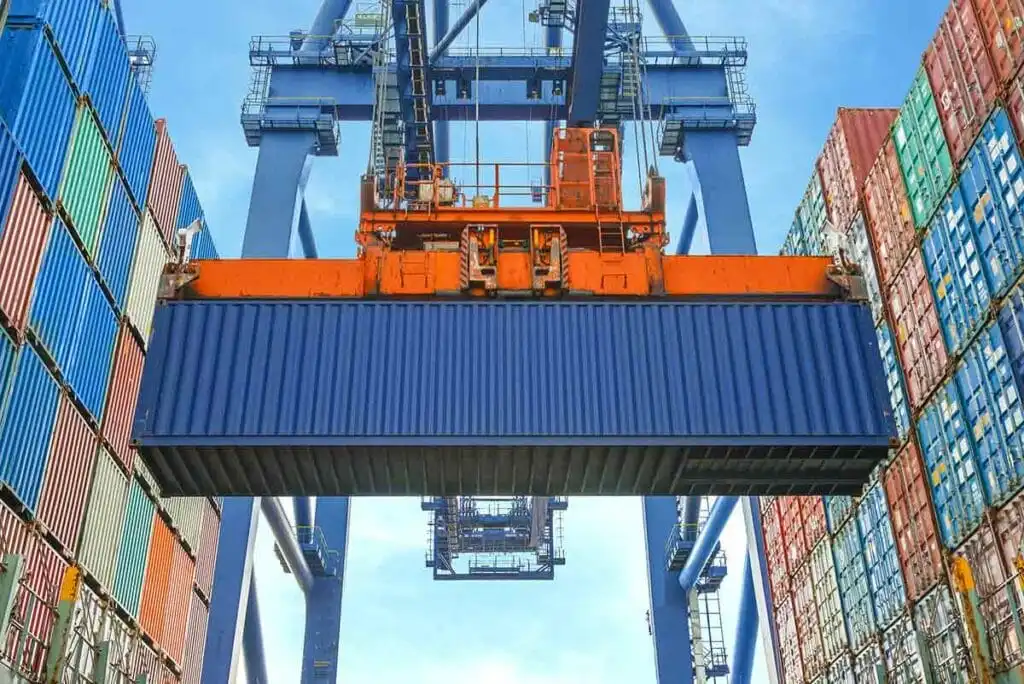
Shipping container dimensions used in Australia can vary significantly and in this article, we’ll help you understand the most common container sizes handled by most shipping companies.
There are many different container sizes used internationally, so right now there are no ‘standard’ shipping container sizes.
You may hear shipping containers referred to as ISO shipping containers.
ISO stands for the International Organisation for Standardization, an international group that creates standards (determines the specification and dimensions of things) to simplify and make consistent all things worldwide.
The cost to purchase ISO documentation and comply with ISO standards is high, so many industries are slow to adopt them. This is particularly true it the shipping industry which has been around a lot longer than ISO.
Common Shipping Container Dimensions
In Australia, the most common shipping container is the 20ft container, commonly with an external metric measurement of 6.096 metres or 6,096 millimetres. Slight variations in container specifications tend to occur so the figures listed should be checked before hiring or purchasing a container.
10ft Shipping Container Dimensions |
|||||
|
INTERNAL |
EXTERNAL |
WEIGHT |
|||
|
Length (mm) |
2,794 |
Length (mm) |
3,048 |
Tare (kg) |
1,200 |
|
Width (mm) |
2,348 |
Width (mm) |
2,438 |
Payload (kg) |
8,860 |
|
Height (mm) |
2,384 |
Height (mm) |
2,591 |
Max Gross (kg) |
10,160 |
|
Container Volume 559 CFT | 15.8 CBM |
|||||
ISO 668 : 1D – 10ft Shipping Container Dimensions |
|||||
|
INTERNAL |
EXTERNAL |
WEIGHT |
|||
|
Length (mm) |
2,802 |
Length (mm) |
2,991 |
Tare (kg) |
1,300 |
|
Width (mm) |
2,330 |
Width (mm) |
2,438 |
Payload (kg) |
8,860 |
|
Height (mm) |
2,197 |
Height (mm) |
2,438 |
Max Gross (kg) |
10,160 |
|
Container Volume 561 CFT | 15.9 CBM |
|||||
20ft Shipping Container Dimensions |
|||||
|
INTERNAL |
EXTERNAL |
WEIGHT |
|||
|
Length (mm) |
5,898 |
Length (mm) |
6,096 |
Tare (kg) |
2,290 |
|
Width (mm) |
2,348 |
Width (mm) |
2,438 |
Payload (kg) |
28,190 |
|
Height (mm) |
2,384 |
Height (mm) |
2,591 |
Max Gross (kg) |
30,480 |
|
Container Volume 1,165 CFT | 33.0 CBM |
|||||
ISO 668 : 1CC – 20ft Shipping Container Dimensions |
|||||
|
INTERNAL |
EXTERNAL |
WEIGHT |
|||
|
Length (mm) |
5,867 |
Length (mm) |
6,058 |
Tare (kg) |
2,000 |
|
Width (mm) |
2,330 |
Width (mm) |
2,438 |
Payload (kg) |
34,000 |
|
Height (mm) |
2,350 |
Height (mm) |
2,591 |
Max Gross (kg) |
36,000 |
|
Container Volume 1,137 CFT | 32.2 CBM |
|||||
40ft Shipping Container Dimensions |
|||||
|
INTERNAL |
EXTERNAL |
WEIGHT |
|||
|
Length (mm) |
12,032 |
Length (mm) |
12,192 |
Tare (kg) |
3,770 |
|
Width (mm) |
2,348 |
Width (mm) |
2,438 |
Payload (kg) |
26,710 |
|
Height (mm) |
2,384 |
Height (mm) |
2,591 |
Max Gross (kg) |
30,480 |
|
Container Volume 2,389 CFT | 67.6 CBM |
|||||
40ft High Cube Shipping Container Dimensions |
|||||
|
INTERNAL |
EXTERNAL |
WEIGHT |
|||
|
Length (mm) |
12,032 |
Length (mm) |
12,192 |
Tare (kg) |
3,990 |
|
Width (mm) |
2,348 |
Width (mm) |
2,438 |
Payload (kg) |
26,490 |
|
Height (mm) |
2,693 |
Height (mm) |
2,896 |
Max Gross (kg) |
30,480 |
|
Container Volume 2,694 CFT | 76.3 CBM |
|||||
40ft Flat Rack Shipping Container Dimensions |
|||||
|
INTERNAL |
EXTERNAL |
WEIGHT |
|||
|
Length (mm) |
11,652 |
Length (mm) |
12,048 |
Tare (kg) |
5,900 |
|
Width (mm) |
2,245 |
Width (mm) |
2,438 |
Payload (kg) |
49,100 |
|
Height (mm) |
2,265 |
Height (mm) |
2,264 |
Max Gross (kg) |
55,000 |
|
Container Volume 1,860 CFT | 52.7 CBM |
|||||
ISO 668 : 1AA – 40ft Shipping Container Dimensions |
|||||
|
INTERNAL |
EXTERNAL |
WEIGHT |
|||
|
Length (mm) |
11,998 |
Length (mm) |
12,192 |
Tare (kg) |
2,000 |
|
Width (mm) |
2,330 |
Width (mm) |
2,438 |
Payload (kg) |
34,000 |
|
Height (mm) |
2,350 |
Height (mm) |
2,591 |
Max Gross (kg) |
36,000 |
|
Container Volume 2,320 CFT | 65.7 CBM |
|||||
Glossary of Container Shipping Terms
Like many other industries there is a lot of jargon, slang and terminology used in shipping and logistics.
Here is a list definitions for words used in paperwork and negotiations when dealing with shipping containers.
Aboard
Refers to cargo or container(s) being put on a vessel (ship, truck, airplane, etc) for transportation.
Advance
To move cargo or a container to a vessel leaving sooner than the one booked.
All In
The total price to move a container from origin to destination, inclusive of all charges.
Alongside
Cargo or containers delivered alongside are placed on the dock or barge within reach of a ship’s rigging so it can be easily loaded onto a ship.
Apparent Good Order
When freight appears to be free of damage after being assessed by a general survey.
ATDNSHINC
Is an acronym referring to when a vessel will operate – Any Time Day or Night Sundays & Holidays Included.
AUSFTA
Is an acronym for Australia-United States Free Trade Agreement. A bilateral free trade agreement between the USA and Australia that implements a wide variety of trade policies intended to be mutually beneficial for both countries.
Backhaul
Cargo or container carried on a return journey; hauling a shipment back over part of a route already traveled.
Bill of Lading
Often abbreviated as BOL, BoL, B/L or BL. A Bill of Lading is a document issued by a carrier or their agent acknowledging receipt of a container for shipment.
Bogie
A set of wheels built specifically as rear wheels under a container for rail.
Bolster
A device fitted on a chassis or railcar to hold and secure a container.
Break Bulk
Cargo that is not shipped in a container.
Broken Stowage
The void or empty space in a container not occupied by cargo.
Bull Rings
Devices mounted in the floor of a container that allows lashing and securing of cargo within the container.
Cabotage
Transporting a container between two places in the same country by a transporter from another country.
Cargo
Any thing being transported, regardless of the mode of transport.
CBM
The abbreviation for cubic meter, which is a measurement of volume (where one CBM is measured as one meter wide by one meter long by one meter high).
CFS
An abbreviation used for Container Freight Station, which is a shipping dock where cargo is loaded/unloaded from containers.
CFT
Chassis
A base frame with wheels, that locks onto a container and is used to secure a container so that it can be moved.
COFC
The acronym for Container On Flat Car; a rail freight service where a loaded or empty container is transported on a train’s flatcar.
Concealed Damage
Damage that is not evident from viewing the unopened container/cargo.
Container
A truck trailer loaded with cargo that can be detached for loading onto a vessel. There are different types of containers for different shipping needs. For example, a container may be ventilated, refrigerated, insulated, dehumidified or equipped with special devices used to secure certain types of cargo.
Container Depot
A designated area where empty containers can be picked up or dropped off.
Container Gross Weight
Container Load
Container Manifest
A document detailing the contents of a container, its point of origin and point of destination.
Container Terminal
A facility or designated area where cargo containers are transferred between different modes of transportation. Containers are picked up, dropped off, maintained and housed here.
Container Yard
Abbreviated to CY, a Container Yard is a storage facility for empty containers.
Containerisable Cargo
Cargo that will fit into a shipping container.
Containerisation
Cargo sufficient in size to fill a container either by cubic measurement or by weight.
Corner Posts
Vertical struts fitted at the corners of a container, integral to the corner fittings and connections for the roof and floor of the container.
Cross Member
Transverse piece fitted to the bottom side rails of a container, which support the floor and adds support to the container.
Cube Out
When a container reaches its volumetric capacity before its permitted weight limit is reached.
Cut-Off Time
The latest time cargo may be delivered to a terminal for loading.
D&H
The abbreviation for Dangerous and Hazardous.
Deconsolidation Point
A location where non-containerised and other cargo is separated in preparation for delivery.
Deficit Weight
The weight by which a shipment is less than the minimum weight.
Devanning
Also called Stripping, is the unloading of cargo from a container. Stuffing is the term used for putting cargo into a container.
Diversion
A change made to the route of a shipment or to the route of the entire vessel.
Dock
For sea transport, a cargo handling area adjacent to the shoreline where a ship ties up. For land transport, a loading or unloading platform.
Dolly
A small platform on wheels used for holding heavy objects, such as supporting the front of a container.
Dry Cargo
Any cargo that is not a liquid or does not require temperature control.
Dry–Bulk Container
A container constructed to carry grain, powder and other free–flowing solids in bulk.
Dunnage
Supports used to secure cargo while in transit, including wood or metal blocks, boards, burlap and paper.
Empty Repo
Slang for Empty Repositioning; it means the movement of empty containers.
ETA, ETC, ETD, ETR, ETS
Acronyms for Estimated Time of – Arrival, Completion, Departure, Readiness or Sailing.
FEU
The abbreviation for Forty-foot Equivalent Unit and used to describe a standard 40-foot shipping container, measuring approximately 40 feet long, 8 feet wide and 8.1 feet high.
False Billing
Misrepresenting cargo freight or weight on shipping documents.
Flat Rack
A specialised container with walls only at the short ends of the container.
Gross Weight
Entire weight of goods, packaging and freight container, when ready for shipment.
Gross Vehicle Weight
Also GVW, this is the total weight of a vehicle including the weight of the vehicle itself and any attached containers.
In Bond
Cargo moving under Customs control where duty has not yet been paid or inspections have not yet been conducted.
Insulated Container
A container with insulation on the walls, roof, floor, and doors, to reduce the effect of external temperatures on the cargo.
Laden
Loaded on a vessel.
Lanemeter
A measurement used to indicate the cargo capacity of a roll–on/roll–off car carrier.
Lien
A legal claim upon cargo for the satisfaction of a debt or duty.
Max Gross
The maximum weight of a container plus its cargo, packaging and dunnage. May be abbreviated to MGW.
MCFS
The acronym for Master Container Freight Station. See CFS.
Measurement Cargo
Freight on which transportation charges are calculated on the basis of volume measurement.
Mixed Container Load
A container or trailer loaded with a variety of different things in a single consignment.
MT
Acronym for Metric Ton.
MultiTank Container
A container frame fitted to accommodate two or more separate tanks for transporting liquids.
Nested
Cargo packed so that one unit rests partially or entirely within another, thereby reducing the cubic–foot displacement.
Net Weight
The weight of cargo excluding the weight of their packaging and container.
No–show
Cargo which has been booked but does not arrive in time to be loaded.
Open Top Container
A container fitted with a solid removable roof (or a tarpaulin roof which is sometimes called a Rag Top) so the container can be loaded or unloaded from the top.
Optimum Cube
The highest level of cube volume utilisation that can be achieved when loading cargo into a container.
Overheight Cargo
Cargo over eight feet high (2.4 metres) which means it does not fit into a standard shipping container.
Pallet
A platform or flat structure made of wood, plastic, composite, or metal, on which cargo is secured for shipping.
Payload
Per Diem
A charge or allowance, based on a fixed daily rate.
Rate Basis
The combination of factors (eg. weight, size, packaging, taxes, govt charges etc) that make up the formula used to determine freight rates.
Relay
The transfer of containers from one vessel to another when both vessels are controlled by the same carrier.
Roll-on/Roll-off
Ship’s Tackle
Equipment such as rigging and cranes that are used on a ship for loading or unloading cargo.
Side Loader
A lift truck fitted with lifting attachments operating to one side for handling containers.
Side–Door Container
A container fitted with a rear door and a minimum of one side door.
Skids
Sets of parallel runners, fitted under boxes or packages to raise them clear of the floor to give easy access for a forklift or other handling equipment.
Spotting
Placing a container where it is needed to be loaded or unloaded.
Spreader
A piece of equipment designed to lift containers by their corner castings.
STC, STW
The acronym for Said To Contain, Said To Weigh.
Stowage
Stripping
Also known as Devanning, it is the removing cargo from a container.
Stuffing
Also known as Vanning, it refers to putting cargo into a container.
Tail
The back of a container (opposite the front) or trailer.
Tare Weight
Temperature Recorder
Also called a Temperature Tracker, it is a device to automatically store temperature readings. It provides a record of temperature conditions inside a container while in transit.
Terminal
An assigned area in which containers are prepared for loading into or unloading from a vessel – ship, train, truck, or airplane.
TEU
3PL
The acronym for Third Party Logistics. It is when a company offers outsourced logistics services, which encompass anything that involves management of one or more facets of procurement and fulfilment activities, such as warehousing, freight forwarding and transportation.
Tonnage
Weight in tons. Also refers to the size or carrying capacity of a ship measured in tons
TL
Acronym for Trailer Load.
Transport
The act of moving cargo from one place to another.
Turnaround
Twist Locks
A set of four twistable bayonet type keys used as part of a spreader or chassis to pick up a container or secure containers.
Ullage
The amount by which a liquid carrying container (drum or tank) falls short of being full.
Unit Load
Vanning
Ventilated Container
Vessel
Warehouse
A place for receiving, consolidation, distribution, and storage of goods and cargo.
Warehousing
Temporarily storing goods and cargo.
Weight Cargo
Cargo that is charge transportation costs based on weight.
W/M
Abbreviation used for ‘Weight or Measurement’ and also known as ‘WORM’. It is the shipping rate calculation used either by weight or dimensions; where the calculation that produces the highest revenue for the shipment is billed.





